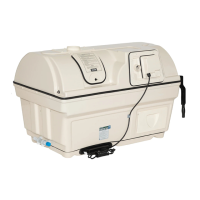PO-MANU0-0609XX
February 2009
Rev D6
Serial
#
________________
CENTREX 2000 FAMILY
OWNER’S MANUAL
Product Info: (905) 332-1314 Fax: (905) 332-1315 Tech. Service: (888) 341-0782
E-mail: compost@sun-mar.com http://www.sun-mar.com
600 Main St. 5370 South Service Rd.
Tonawanda, N.Y. Burlington, ON
14150-0888 U.S.A. L7L 5L1 CANADA
RATED CAPACITY
Weekend & Vacation Use
(Cottage Use)
NE Units; 6 Adults
Electric Units; 7 Adults
Residential & Continuous Use
NE units: 3 Adults
Electric Units; 4 Adults
Standard 41
Certified for liquid
containment, odors, and solid
end products in cottagel use
Certified to NSF/ANSI Standard 41
CENTREX 2000
CENTREX 2000 AC/DC
CENTREX 2000 NE


